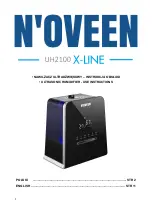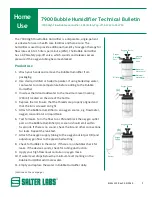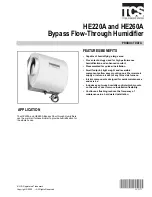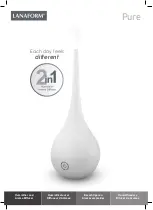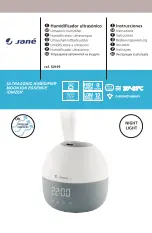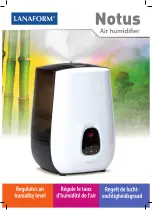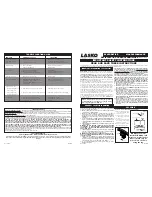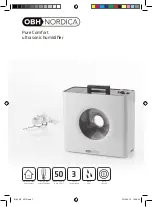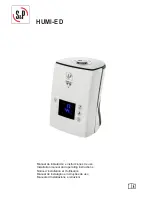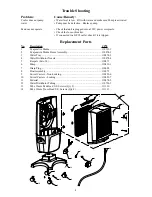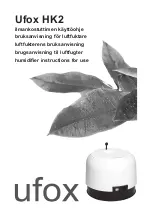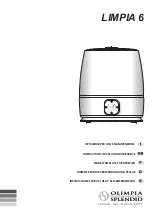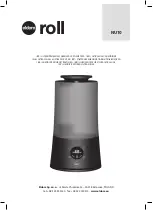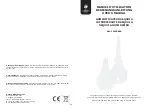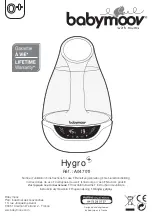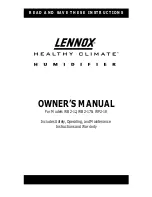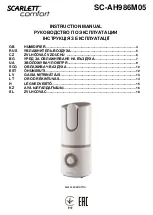
CLEANING and FILTER CARE
1. Regular cleaning is necessary to ensure proper and
efficient operation. The frequency of cleaning
depends on the amount of impurities which may be
found in the water or how often the Humidifier is in
operation. In either instance, it is recommended that
the Humidifier be cleaned at least once a week.
CAUTION:
To prevent electric shock, always turn
Control Knob to OFF (0) position and unplug the
Humidifier before cleaning.
2. Remove Upper Housing from Base. Be careful
not to let excess water from pump spill onto
furniture or flooring.
3. With Water Lens pushed down, the filter may be
removed for cleaning or replacing.
(Figure 4)
4. Remove Evaporative Pad Holder from Base and
inspect Small Water Drip Holes for any blockage.
(Figure 5)
It is important that these Drip Holes remain open at all
times for proper water supply to Evaporative Pad.
5. To increase the life of your Evaporative Pad, unsnap
Holder, remove Pad and flip over.
(Figure 6)
Evaporative Pad life may be extended by cleaning the
Pad in a vinegar solution. To clean Pad, mix one part
undiluted vinegar with four parts warm tap water. Soak
the Pad in this solution for 20 minutes, rinse Pad
thoroughly with warm water to remove vinegar odor.
DO NOT FLATTEN, SQUEEzE OR TWIST FILTER
WHEN CLEANING.
Rev. D 3/08
3
2084152
6. Discoloration of the Evaporative Pad is normal after
extended use. The discoloration is caused by mineral
deposits in the water, and the degree of discoloration
will vary depending upon the amount of mineral
content in the water. When the Pad surface area is
thoroughly discolored, or you notice reduced water
usage, it is a good indicator that the Evaporative Pad
needs to be replaced. The Evaporative Pad should
be replaced at least once every season.
The Replacement Pad to be used in this unit is:
T h e L a s k o R e p l a c e m e n t E v a p o r a t i v e P a d
Model THF 15 (Available Separately)
7.
TO DESCALE BASE AND DRIP SHIELD:
Mix one
part undiluted white vinegar with four parts warm
tap water. Let vinegar solution stand for 20 minutes
then wipe away any scale buildup using a soft brush
or cloth. Do not use soap or detergents and never
use an abrasive cleaner.
8.
TO DISINFECT BASE AND DRIP SHIELD:
Fill with
1 teaspoon of chlorine bleach and 1 gallon of water.
Let solution stand for 20 minutes. Carefully empty Jug
and rinse well with water until bleach smell is gone.
9. Use a dry soft cloth to wipe the Chassis area, which
includes the motor area. DO NOT use water to clean
the Motor or Switch area. Doing so may result in elec-
trical shock or damage to the Humidifier.
10.Commercial “Descalers” and “Bacteriostats” are
available at your local home improvement center.
11.Do not operate Humidifier when there is still cleaner
in the water.
Filter
Figure 4
Water
Lens
Evaporative Pad
Evaporative Pad
Holder
Drip Holes
Figure 6
Figure 5
1. It is recommended that all Humidifiers be cleaned
prior to use. Please read the CLEANING and
FILTER CARE section on page 3 for cleaning
instructions.
2. Remove the Upper Housing from the Base. Make
sure that the
Evaporative Pad Holder
is properly
placed in the
Base
.
(Figure 1)
3. The Humidifier unit will produce approximately 3
gallons in a 24 hour period*, however, the actual
water capacity (amount of water the Humidifier will
hold at one time) is 1.75 gallons.
4. You may fill your Recirculating Evaporative
Humidifier two different ways:
A) Fill the Base with cool water to level indicated
in
Figure 2A
.
B) Replace the Upper Housing on the Base and
push Water Lens down to pour water into the
Humidifier
(Figure 2B)
until it reaches the
level indicated in Figure 2A.
DO NOT OVERFILL UNIT.
OVERFILLING THE HUMIDIFIER WILL
CAUSE MOTOR DAMAGE.
NEVER USE HOT WATER WHEN FILLING
HUMIDIFIER.
OPERATION INSTRUCTIONS
Rev. D 3/08
2
2084152
FILLING HUMIDIFIER
Evaporative Pad
Holder
Figure 1
Base
Maximum Water
Level
Figure 2A
Water Lens
Figure 2B
CAUTION:
Always place Humidifier on a firm and level
surface. Locate the Power Cord so the Humidifier is not
resting on it, and the cord is away from room traffic.
Always carry filled Humidifier carefully. Never move
water filled Humidifier while plugged in.
1. Take extra care to prevent water spillage that may
damage furniture or flooring. The manufacturer will
not accept responsibility for damage to property
caused by water spillage.
2. Always be sure that the Power Control Knob is in
the OFF (0) position when plugging Humidifier into
a polarized 120 volt AC wall outlet.
CAUTION:
Do not Plug Humidifier into electrical outlet
with wet hands, or electrical shock may occur.
3. Set Moisture Control Knob to regulate desired
amount of humidity.
(Figure 3)
HIGH (3):
For fast humidification of
a large room. This setting will provide
approximately 3 gallons of moisture
output in a 24 hour period.*
MED (2):
For normal operation.
LOW (1):
For quiet, night time
operation.
OFF (0):
Turn unit off when refilling,
cleaning or moving the humidifier.
* Calculations based on ambient conditions of 70° F and
30% relative humidity in a room of average insulation.
4. Water usage will vary depending upon initial
humidity level in the room. If humidity is low,
the Unit will use water more rapidly until the
humidity in the room is stabilized. If the humidity
is already near or above 50% relative humidity,
water consumption will be low.
CAUTION:
Be careful not to direct airflow towards
walls or furniture, as excessive moisture may cause
damage.
5. Refill Humidifier when water level in the Base is low.
Refer to the FILLING HUMIDIFIER section above.
6. If you do not plan to use your Humidifier for sev
-
eral days, empty all water from the Unit. Standing
water may provide an environment for the growth
of algae or bacteria.
CAUTION:
Do not pour water through
the Exhaust Grill on the Upper Housing.
Doing so may cause damage and
personal injury.
Figure 3



